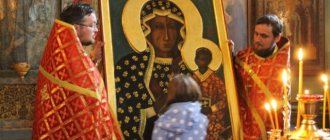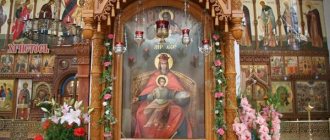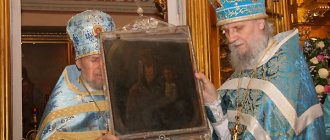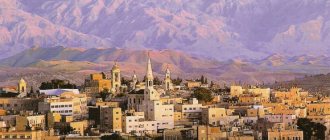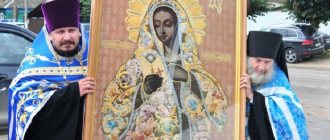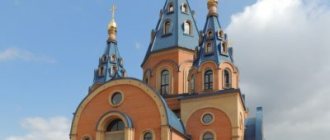The weeping icon of the Mother of God in Paris is a copy of the great Russian shrine (PHOTO)
Suzdal, March 4, 2015
“The Orthodox icon of the Mother of God from the Byzantine period, which a Turkish family found in Antakya and brought with them to Paris (even though they are Muslims), began to shed tears,” writes the Greek portal Romfea. As Aldidaroglu themselves say, this icon was given to them by a Greek Orthodox monk from Libya in 2006. People from different countries come to pray to the miraculous image. We also learned about it in Russia...
But one glance at the photograph of the wonderful image was enough to immediately recognize: this is a copy of the great shrine of the Intercession Monastery in the city of Suzdal! It's a copy, not a list. It is impossible to make a list exactly like a sample, like a photograph.
Icon of the Mother of God crying in Paris
The fact is that the iconography of this icon is completely unique. By mistake, for some time she was called Georgian because of the open maforia on her chest, revealing a corner of the tunic of the Mother of God. It differs from the traditional iconography of Hodegetria in the position of the right hand of the Mother of God: it lies on the feet of the Infant God, as on the icon of the “Our Lady of Rome” or the icon of the “Mammal.” It is distinguished by the position of the Child and His clothes. And the most seemingly inconspicuous difference is the blessing right hand of the Baby. It completely matches the maforia border! The God-Infant, as it were, hides Himself, but reveals His Mother to us. An icon painter would not repeat this. This was repeated by some kind of photo technology. Eyes are written on top of this copy. But more on that later.
The shrine itself is kept in the Tretyakov Gallery and dates back to the sixties of the 14th century. The inventory of the Suzdal Intercession Convent of 1597 describes in detail the precious decoration for this temple icon of the Most Pure Mother of God, consisting of 225 items - all of them were brought in gratitude for the miracle performed.
Icon from the Suzdal Intercession Convent
According to legend, it was in front of this icon that the meek Tsarina Anastasia Romanovna prayed for the birth of an heir. And she gave birth to three sons one after another. In 1552, before the campaign against Kazan, Tsar Ivan the Terrible, having served a prayer service in the Pokrovsky Suzdal Monastery, heard the words of Abbess Vasilisa quietly spoken after him: “You will return as the Tsar of Kazan.”
He turned around and promised to put his most beloved image into the monastery if the abbess’s words came true. Having taken Kazan for Intercession, the tsar, “on the way back”, fulfilled his promise, personally taking care of decorating the icon, and hanging gold earrings with pearls, turquoise and carnelians from the crown of the Queen of Heaven.
Anastasia Romanovna, in gratitude for the birth of her son, embroiders a hanging shroud and linings. The next wife of Ivan the Terrible, Maria Temryukovna, thanks the icon with a pearl necklace of the finest work. The young queen, the 18-year-old wife of Tsar Vasily Shuisky, who buried her first daughter, was tonsured into the Intercession Monastery along with her newborn daughter, who soon also departed. What she prayed for, how the Mother of God consoled her, only one silent witness knows - the Tsarina’s golden rock cross on the chest of the Queen of Heaven.
The Intercession Monastery, which became the place of tonsure, monastic feat and resting place of many eminent persons, including the wife of Vasily III Solomonia Saburova (Saint Sophia of Suzdal), one of the spouses of Ivan the Terrible, Queen Anna, the wife of Vasily Shuisky, Queen Catherine, the wife of Peter I, Evdokia Lopukhina... becomes a place of pilgrimage to the miraculous icon, a place of consolation... By 1910, as we see in the photograph taken by V. Georgievsky, the face on the icon of the Mother of God becomes almost invisible. And in 1920, one of the outstanding restorers of his time, the favorite of the holy Patriarch Tikhon, G.O. Chirikov, carefully uncovered the icon from the darkened linseed oil and the 17th-century recording. Let me remind you that the icon’s precious attire made it impossible to venerate it. Her face could not be “kissed” like the images of saints on the icon of the Intercession from this monastery were kissed. They were applied to the hanging shroud. But on the icon the eyes are practically invisible. The pupils are visible. And my eyes are crying. That's why she consoled and consoles. And in Paris the Mother of God is crying again.
Religious secrets of aromatic oil
Special essential oils, produced using ancient technologies, have been used in the rituals of the Christian religion for quite a long time. Fragrant liquid substances, necessarily consecrated in churches, have at all times been widely used in the rites of anointing a person, consecrating religious buildings, palaces of state rulers, especially altars and thrones. A special term “miro” was applied to these aromatic oils, which came into use from a duet of 2 languages: Old Church Slavonic and Ancient Greek.
Imagine the surprise of believers when a miracle first appeared to the world - drops of an oily liquid spontaneously began to appear on some icons, relics of saints, and religious statues. It seemed that viscous balls of resin, streams, drops of blood or transparent traces of dew, which, according to legend, have healing and cleansing properties, were sent to Earth by heaven itself.
Signs of myrrh-streaming
The miracle does not fit at all into the worldview that scientists present to the people. It is impossible for deep and numerous sinners to understand this mystical process, because they consider it based on the limited ability of discrimination. Ordinary logic is powerless when it comes to divine providence, which is why the Orthodox people turn to faith, which can bring the soul to a serene state.
Interesting! The manifestation of the phenomenon is not influenced by the age of the relic, or the level of professionalism during creation, or location. Fir trees are distinguished by ancient and newly created faces, painted using oil paints, metal ones, printed in a printing house, even frescoes.
In the course of history, special signs have developed:
- Light tears of sacred paintings signify positive changes, and dark (or blood) tears signify bad events.
- Oily myrrh, formed in the form of small drops (dew), speaks of a good future.
- Abundant flow of fragrant liquid portends good news.
- If an icon cries within the walls of God’s house, it means better times will come for the church and its parishioners; if this happens at home, an important event for the family, healing, will take place. When a layman saw a miracle in his apartment, he should seek advice from a priest and invite the priest into the house to witness the fact. It is necessary to take the release of fragrant oil with due seriousness and wait for good changes.
The myrrh flowing from the icon has unique healing properties
The scientific community is unable to answer the question about the very essence of the process of extracting fragrant myrrh from church linens. Scientists took into account almost all external physical circumstances that could potentially cause this mysterious phenomenon. The research examination paid attention to lamp oils located next to the “crying” face, oil traces left by touching and kissing parishioners, etc.
There are known cases when myrrh flowed upward or across, violating the natural laws of physics.
How can icons cry?
A weeping icon does not mean at all that tears will flow from the eyes of the image; it is most correct to say that a special oil begins to be released, which is called myrrh, but this oil should not be confused with another, which is prepared by priests and used for Orthodox rites.
Very rarely, oil begins to appear on icons that has nothing in common with the oil that is used for anointing. The tears of an icon can be of different consistency, for example, oil can be thick or liquid.
Why does the icon shed blood?
Icons and images do not literally cry blood. If the process of myrrh-streaming is not artificially faked (that is, there are no special holes in the icon that release moisture or oil), then most likely the myrrh is mixed with paint, that the image was painted, which in its mixed state has a brownish tint.
IMPORTANT: From an esoteric point of view, such a phenomenon can be regarded as a sign. Warning about events in the future (most often bad: war, losses, disputes, death, illness).
Why do icons cry blood?
Historical cases and interesting facts about myrrh-streaming icons
For the first time, the weeping icon was seen in Veliky Ustyug. A holy fool named Procopius lived here, who had a special gift of foresight. Procopius called on people to repent, otherwise they would all perish. No one took Procopius' words seriously, and then one day a black cloud appeared over the city and covered the entire city. Frightened people rushed to pray near the icon in the church, which immediately began to exude myrrh. The parishioners collected it in vessels, and then anointed themselves and thanked God for forgiving them of their sins.
Later, a miracle happened again, and already in 1953, an icon of the Virgin Mary with a baby in her arms was shed in Sicily. There was too much controversy around this case, but scientists wanted to check the authenticity of the tears. And when they took the liquid for analysis, they were convinced that it was real human tears in composition.
Another miraculous weeping icon is the “Laying of the Crown of Thorns on the Savior’s Head.” This icon is located in the Church of the Holy Sepulcher. Myrrh began to stand out in the image back in 1572. That year, streams of fragrant oil constantly flowed down the icon, which somewhat resembled blood, and this was a sign before the terrible tragedy that happened in France. Later this event became known as St. Bartholomew's Night.
Why do icons stream myrrh and cry in churches and at home: folk signs
Interpretations will accept:
- The icon “cries” is a sign that foreshadows changes in the future; if the “tears” are light, they will be good, if dark, they will be bad.
- The icon was covered with “dew” - a good sign that tells you that everything will be fine.
- The icon streams myrrh abundantly - a good sign of approaching favorable events.
- The icon streams myrrh in the church - a favorable sign for the church, city, and parishioners.
- The icon streams myrrh at home - a good event will happen in the family
Opinion of scientists and skeptics
The analysis of information about the miracles of the new appearance of oily incense is always subject to doubt and study. Scientists have already concluded that the birth of aromatic oil on icons is more typical for “young” icon-painting creations, and they are trying to explain the appearance of myrrh or blood drops on statues by describing the properties of the materials for their manufacture or secret holes with liquids invisible to the naked eye.
Skeptics take it upon themselves to claim that the streaming of myrrh from icons and statues is a hoax designed to revive the population’s interest in religion. Miracles with myrrh are explained by capillary effect, condensation of vapors of aromatic oils used in lamps, or fraudulent application of oily liquids to the contact surface.
Controversy continues over the appearance of bloody marks on icons, red tears and discharge appearing in various places on the statues. Humanity will still have to put an end to the explanation of miraculous phenomena in the future, but for now the flow of myrrh remains a mystery that invariably attracts the attention of parishioners and the public.
« Previous entry
Conclusions of the high commission
Without any exaggeration, theologians regard the miraculous sobs of the great saints as a certain sign, the meaning of which no one has yet been able to decipher. So that the phenomenon would not raise any doubts among the curious public and the Christian flock, theologians decided to take a desperate step - the creation of a single commission uniting clergy and atheists. The result of the commission’s work is disappointing: crying and lamentation of icons and relics takes place and increases in arithmetic progression. Previously, miraculous phenomena invariably foreshadowed a change in the course of world history or prophesied significant events.
Laboratory test results
Scientists in different parts of the world tried to conduct a laboratory analysis of the aromatic liquid emerging from nowhere. A series of analyzes showed that the chemical composition of the mysterious liquids is never repeated, blood usually belongs to men or women and has different groups, and aromatic secretions generally represent a variety of solutions of organic and inorganic substances.
Church laws turned out to be a serious obstacle to scientific research - holy icons and statues cannot be subjected to blasphemous experiments. The light droplets were carefully collected into vessels for myrrh and became a sacred rarity for parishioners and clergy.
On some icons, fragrant vapors appear with enviable consistency and even at certain times; other holy relics showed their miraculous properties to the world only once, losing their magical ability. It can be considered interesting that the streaming of myrrh from icons and statues has become widespread in recent decades. The process began in the 90s of the 20th century; the 20th century did not smooth out the process of manifestation of the miracle; on the territory of Russia, Belarus and Ukraine, the “cry of the saints” took on a mass character.

